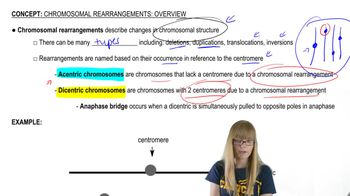Table of contents
- 1. Introduction to Genetics51m
- 2. Mendel's Laws of Inheritance3h 37m
- 3. Extensions to Mendelian Inheritance2h 41m
- 4. Genetic Mapping and Linkage2h 28m
- 5. Genetics of Bacteria and Viruses1h 21m
- 6. Chromosomal Variation1h 48m
- 7. DNA and Chromosome Structure56m
- 8. DNA Replication1h 10m
- 9. Mitosis and Meiosis1h 34m
- 10. Transcription1h 0m
- 11. Translation58m
- 12. Gene Regulation in Prokaryotes1h 19m
- 13. Gene Regulation in Eukaryotes44m
- 14. Genetic Control of Development44m
- 15. Genomes and Genomics1h 50m
- 16. Transposable Elements47m
- 17. Mutation, Repair, and Recombination1h 6m
- 18. Molecular Genetic Tools19m
- 19. Cancer Genetics29m
- 20. Quantitative Genetics1h 26m
- 21. Population Genetics50m
- 22. Evolutionary Genetics29m
6. Chromosomal Variation
Chromosomal Rearrangements: Overview
Problem 2
Textbook Question
Textbook QuestionWrite a short essay that discusses five altered phenotypes that result from specific chromosomal aberrations.
 Verified Solution
Verified SolutionThis video solution was recommended by our tutors as helpful for the problem above
Video duration:
1mPlay a video:
Was this helpful?
Key Concepts
Here are the essential concepts you must grasp in order to answer the question correctly.
Chromosomal Aberrations
Chromosomal aberrations refer to changes in the structure or number of chromosomes, which can lead to genetic disorders. These alterations can be classified into two main types: numerical aberrations, where there is an abnormal number of chromosomes (e.g., trisomy 21), and structural aberrations, which involve breaks, deletions, duplications, or rearrangements of chromosome segments. Understanding these aberrations is crucial for linking them to specific phenotypic outcomes.
Recommended video:
Guided course

Aberrant Euploid
Phenotype
A phenotype is the observable physical or biochemical characteristics of an organism, determined by both genetic makeup and environmental influences. Altered phenotypes resulting from chromosomal aberrations can manifest in various ways, such as changes in physical appearance, metabolic functions, or susceptibility to diseases. Recognizing how specific chromosomal changes lead to distinct phenotypic expressions is essential for understanding genetic disorders.
Recommended video:
Guided course

Mutations and Phenotypes
Genetic Disorders
Genetic disorders are diseases or conditions caused by abnormalities in an individual's DNA, which can arise from chromosomal aberrations. These disorders can be inherited or occur de novo and often result in altered phenotypes that affect an individual's health and development. Examples include Down syndrome, Turner syndrome, and Klinefelter syndrome, each associated with specific chromosomal changes and distinct phenotypic traits.
Recommended video:
Guided course

Descriptive Genetics

 4:38m
4:38mWatch next
Master Rearrangement Overview with a bite sized video explanation from Kylia Goodner
Start learningRelated Videos
Related Practice


